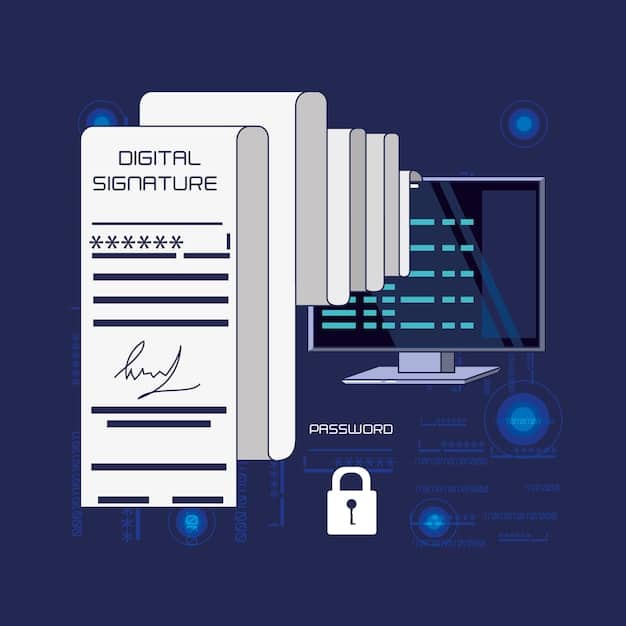Decoding Cybersecurity Legislation: Protecting US Businesses

Decoding the New Cybersecurity Legislation: Protecting Your Business from Evolving Threats is critical for US businesses. Understanding these laws ensures compliance, safeguards data, and mitigates potential financial and reputational damage from cyberattacks.
In today’s digital landscape, cybersecurity is no longer optional; it’s a necessity. For businesses in the US, understanding and complying with cybersecurity legislation is crucial for survival. This article aims at decoding the New Cybersecurity Legislation: Protecting Your Business from Evolving Threats.
We’ll explore key aspects of these laws, helping you protect your organization from increasingly sophisticated cyberattacks and ensure compliance. Let’s delve into practical strategies and insights to safeguard your digital assets and maintain your competitive edge.
Decoding the New Cybersecurity Legislation
Navigating the complex world of cybersecurity legislation can feel daunting. Decoding the New Cybersecurity Legislation: Protecting Your Business from Evolving Threats means understanding the specific laws that affect your industry and business operations. It involves more than just knowing the names of the laws; it also requires interpreting their requirements and implementing appropriate security measures.
Key Federal Laws
Several federal laws play a crucial role in shaping cybersecurity practices for US businesses. Understanding them is the first step in building a robust defense.
- The Cybersecurity Information Sharing Act (CISA): Encourages businesses and the government to share information about cybersecurity threats. This helps in collective defense and rapid response to emerging risks.
- The Computer Fraud and Abuse Act (CFAA): Prohibits unauthorized access to computer systems and data theft. It provides a legal framework for prosecuting cybercriminals.
- The Federal Information Security Modernization Act (FISMA): Applies to federal agencies and contractors, requiring them to implement comprehensive security programs. While not directly applicable to all businesses, it sets a standard for cybersecurity best practices.
Staying informed about these laws and their implications is essential for maintaining compliance and protecting your business from legal liabilities.

In summary, to decode the New Cybersecurity Legislation, protecting Your Business from Evolving Threats isn’t just about understanding; it’s about building a legal shield. By knowing the ins and outs of these federal laws, you’re better equipped to protect your organization. Don’t just comply; lead the charge in cybersecurity.
Understanding State-Level Cybersecurity Laws
While federal laws provide a broad framework, individual states also have their own cybersecurity regulations. These state-level laws often address specific aspects of data protection and breach notification.
California Consumer Privacy Act (CCPA)
CCPA grants California residents significant rights regarding their personal data, including the right to know what information businesses collect about them, the right to delete their personal information, and the right to opt-out of the sale of their data. Businesses operating in California, regardless of where they are headquartered, must comply with CCPA if they meet certain criteria (e.g., annual revenue, number of consumers whose data they process).
New York SHIELD Act
The SHIELD Act requires businesses that possess private information of New York residents to implement reasonable security measures to protect that data. This includes administrative, technical, and physical safeguards. The SHIELD Act also broadens the definition of “private information” and expands the scope of data breach notification requirements.
Other State Laws
Many other states have enacted data breach notification laws that require businesses to inform individuals and regulatory agencies when their personal information has been compromised. Some states also have laws addressing specific types of data or industries, such as healthcare or financial services.

In conclusion, understanding state-level laws completes the process of decoding the New Cybersecurity Legislation: Protecting Your Business from Evolving Threats, ensuring your business acts, not reacts. Being ready on the state level boosts trust, avoids penalties, and keeps your business strong.
Implementing a Cybersecurity Framework
Beyond understanding the laws, implementing a robust cybersecurity framework is essential for protecting your business. This framework should include policies, procedures, and technologies that address various aspects of cybersecurity.
The NIST Cybersecurity Framework
The National Institute of Standards and Technology (NIST) Cybersecurity Framework provides a set of guidelines for organizations to manage and reduce cybersecurity risks. The framework is voluntary but widely recognized as a best practice for cybersecurity. It consists of five core functions: Identify, Protect, Detect, Respond, and Recover.
Key Elements of a Cybersecurity Framework
A comprehensive cybersecurity framework should include the following elements:
- Risk Assessment: Identifying and evaluating potential cybersecurity risks and vulnerabilities.
- Security Policies: Establishing clear policies and procedures for cybersecurity practices.
- Access Controls: Implementing controls to restrict access to sensitive data and systems.
- Data Encryption: Encrypting data both in transit and at rest to protect it from unauthorized access.
Cybersecurity Framework is all about acting, not just reacting. By assessing risks, setting policies, managing access, and encrypting data, you ensure your operations are safe, compliant, and ready for anything.
The Role of Insurance in Cybersecurity
Cyber insurance is becoming an increasingly important component of a comprehensive cybersecurity strategy. It can provide financial protection in the event of a data breach or other cyber incident.
What Cyber Insurance Covers
Cyber insurance policies typically cover a range of expenses, including:
- Data Breach Notification Costs: Expenses associated with notifying affected individuals and regulatory agencies.
- Legal and Forensic Costs: Fees for legal counsel and forensic investigation services.
- Business Interruption Losses: Lost revenue due to system downtime or other disruptions caused by a cyberattack.
- Ransomware Payments: Coverage for ransom demands and related expenses.
Choosing the Right Policy
When selecting a cyber insurance policy, consider the following factors:
- Coverage Limits: Ensure that the policy provides adequate coverage for potential losses.
- Exclusions: Understand the policy’s exclusions and limitations.
- Premium Costs: Compare premiums from different insurers.
Cyber Insurance is a safety net, not a cure. By understanding what these policies cover and choosing the right one, you’re setting up a critical backstop in case of a cyber event.
Training and Awareness Programs
Employees are often the weakest link in the cybersecurity chain. Implementing training and awareness programs can help reduce the risk of human error and social engineering attacks.
Essential Training Topics
Training programs should cover essential topics such as:
- Phishing Awareness: How to identify and avoid phishing emails and other scams.
- Password Security: Best practices for creating and managing strong passwords.
- Data Handling: Proper procedures for handling sensitive data.
- Social Engineering: How to recognize and resist social engineering tactics.
Creating a Security Culture
Promoting a culture of security awareness within your organization can help reinforce training messages and encourage employees to take cybersecurity seriously. This can involve regular security briefings, simulated phishing attacks, and other activities that keep cybersecurity top of mind.
Training and awareness is vital, making employees ready and smart. By regularly educating staff on current threats and best practices, you are turning them into a powerful defense, keeping your business safe and compliant.
Staying Ahead of Evolving Threats
The cybersecurity landscape is constantly evolving, with new threats emerging all the time. Staying ahead of these threats requires continuous monitoring, adaptation, and innovation.
Regular Security Audits
Conducting regular security audits can help identify vulnerabilities and weaknesses in your systems and processes. These audits should be performed by qualified cybersecurity professionals and should include both technical assessments and policy reviews.
Threat Intelligence
Staying informed about the latest cybersecurity threats and trends can help you anticipate and prepare for potential attacks. This can involve subscribing to threat intelligence feeds, participating in industry forums, and working with cybersecurity experts.
Decoding the New Cybersecurity Legislation: Protecting Your Business from Evolving Threats also depends on constantly updating strategies. Staying adaptable is crucial for protecting your business from cyber threats.
| Key Point | Brief Description |
|---|---|
| 🛡️ Federal Laws | CISA, CFAA, and FISMA shape cybersecurity practices. |
| 🏛️ State Laws | CCPA, SHIELD Act, and breach notification laws vary. |
| 🗝️ Cybersecurity Framework | Implement policies, controls, and encryption. |
| 👨🏫 Training Programs | Boost awareness to fight cyber threats effectively. |
Frequently Asked Questions
The primary goal is to understand and implement the legal requirements necessary to protect your business from cyber threats, ensuring compliance and reducing risks.
The NIST framework offers a structured approach to managing and reducing cybersecurity risks through its five core functions: Identify, Protect, Detect, Respond, and Recover enabling better security practices.
Employees are often the first line of defense against cyberattacks. Training helps them recognize and avoid threats like phishing, strengthening the businesses overall security posture.
A comprehensive cyber insurance policy should cover breach notification costs, legal fees, business interruption losses, and potential ransomware payments, providing financial protection after an incident.
Businesses should conduct security audits regularly, ideally at least once a year, to identify and address vulnerabilities, ensuring continuous improvement in their cybersecurity defenses.
Conclusion
Decoding the New Cybersecurity Legislation: Protecting Your Business from Evolving Threats is an ongoing process that requires continuous effort and adaptation. By understanding the laws, implementing a cybersecurity framework, investing in employee training, and staying informed about emerging threats, you can significantly enhance your organization’s cybersecurity posture.
Protecting your business isn’t just about avoiding fines; it’s about maintaining trust with your customers, safeguarding your reputation, and ensuring the long-term success of your organization.





